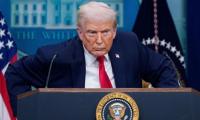The challenge of the ‘Indo-Pacific’
Until recently, the word Indo-Pacific was hardly known, except as a term used in marine biology to describe the tropical regions of the Indian and Pacific Oceans as a fish habitat. Now it is on the lips of every Indian strategist worth his salt. One of them speaks of the
By Asif Ezdi
February 09, 2015
Until recently, the word Indo-Pacific was hardly known, except as a term used in marine biology to describe the tropical regions of the Indian and Pacific Oceans as a fish habitat. Now it is on the lips of every Indian strategist worth his salt. One of them speaks of the “Modi Doctrine for the Indo-Pacific region”. As a former Indian diplomat put it some time ago with obvious relish, “From a geopolitical perspective [the expression Indo-Pacific] represents the inclusion of the Western Pacific within the range of India’s security interests, thus stretching beyond the traditional focus on the Indian Ocean theatre”.
The word as well as the concept, though, is of American provenance, just like another expression – ‘Act East’ – which Indian officials and commentators have embraced enthusiastically. Both terms gained currency following policy statements in 2010 and 2011 by the then Secretary of State Hillary Clinton to underpin the notion that India is not just a large South Asian country but should also play a more active political and economic role in the Asia Pacific region. The whole idea is part of a grand American design first announced to the world by the Bush presidency in 2005 to ‘make India a global power’ to contain China’s rise.
‘Indo-Pacific’ as a concept has also been adopted by Japan and Australia. For this purpose, Tokyo has coined the phrase ‘confluence of the seas’. American officials still use ‘Indo-Pacific’ only in the limited context of India, mostly when welcoming and encouraging Indian activity in the affairs of Asia Pacific. The first part of this particular hyphenation stands not for India though, as India’s great strategic minds might wish, but for the Indian Ocean.
It is possible that like another American geopolitical term, namely the ‘Broader Middle East and North Africa (BMENA)’, which the Bush administration coined and which is hardly heard anymore, ‘Indo-Pacific’ may also turn out to be a short-lived expression. But whatever happens to this term, there is not going to be any change in the American policy of giving India a geopolitical boost and helping it assert a bigger role for itself in the Asia-Pacific and Indian Ocean regions. This was also the purpose of the ‘Joint Strategic Vision of the Asia-Pacific and Indian Ocean region’ announced during Obama’s visit to India. The statement refers to this vast stretch of very diverse territory and ocean as a single region, though the word ‘Indo-Pacific’ is not used.
Much of the media comment on this statement has focused on the support expressed by India in it for “freedom of navigation and overflight throughout the region, especially in the South China Sea”, which is tilted against China’s position on the issue. For Pakistan, however, the importance of the US-India statement lies more in the fact that it amounts to a joint US-Indian project to help India expand its influence in the area “from Africa to East Asia”, which includes but is much wider than what India has traditionally claimed as its “extended neighbourhood”, a kind of Indian ‘Near Abroad’.
The broader aim of this venture, shared by both the US and India, is to contain China’s influence in the Indian Ocean – which India likes to fancy is its backyard – and to enable India to make inroads in the waters of Southeast Asia, where India’s presence so far has been minimal. For India, whose foreign policy continues to be Pakistan-centric despite all talk of de-hyphenation, one more equally important purpose of the ‘strategic vision’ is to isolate Pakistan.
Not surprisingly, China takes a very relaxed view of the Indian challenge and has shrugged it off rather dismissively. The Global Times, a newspaper run by the Chinese Communist Party, gave India some friendly advice not to fall into the trap of rivalry set by the west. The common interests that the two countries share, it said, are much bigger than any differences and they should see more space for cooperation instead of contention.
Pakistan, on the other hand, cannot afford to ignore the Indian ambitions, now that they have the open backing of Washington. The Kashgar-Gwadar Economic Corridor should put a damper on India’s designs to dominate the area. But there is no reason for complacency, certainly not of the kind displayed by Sartaj Aziz in his comments on the US-India plan in his speech on January 29. Pakistan must also strengthen its links with countries of Asia Pacific, where Asia’s strategic and economic centre of gravity lies.
Sartaj’s comments postulate that Asia is divided into two geopolitical halves: the eastern and the western. Sartaj does not say on which side of the dividing line South Asia lies. His is not just a very novel perspective, it is also completely wrong. The main geopolitical dividing line is between East Asia and South Asia, not between east and west. Central Asia is another distinct region. It has been appended to South Asia by the US State Department because Washington would like it to fall in the Indian political and economic orbit.
Sartaj is also wrong in asserting that the US is keen to give India a boost “in the eastern half of Asia” only. The truth is that the US wishes to see India with an enhanced footprint in both South Asia and Central Asia. But because the region is land-locked, the US plans cannot go very far without the participation of Pakistan. That is why the US acknowledges, as Sartaj rightly said, that Pakistan has an indispensable role in promoting stability and facilitating connectivity in ‘Central and West Asia’.
For us, the second important point of the strategic vision document is that the US has supported India’s admission into Apec, a grouping of 21 Pacific Rim countries. According to the New York Times, in his meeting with Obama, Modi “expressed interest in playing a greater role in [Apec], where India could help balance China’s influence”. India’s possible role as a potential counterweight to China thus seems to have helped in the US decision to support India’s bid.
Only a week later, India also won support for its Apec bid from China and Russia at a trilateral meeting of the foreign ministers of the three countries in Beijing. China’s support had in fact been signalled in an invitation extended last July by the Chinese president to Modi to visit China on the occasion of an Apec summit that China hosted last November.
Having won the support of US, China and Russia, India’s admission is now assured. It is now expected that India will be formally admitted to Apec at the group’s next summit in Manila in November this year.
Pakistan has also sporadically expressed interest in Apec membership, as well as other regional groupings of Asia Pacific, but has not made any serious concerted effort among the member countries, mainly because of a lack of commitment at the leadership level. The prime minister squandered an excellent opportunity to take up the question when he visited Beijing last November to participate in the ‘Dialogue on Strengthening Connectivity Partnership’ which took place a few days before the Apec Summit.
But it is not just the prime minister’s fault. In two speeches last year on Pakistan’s foreign policy, Special Assistant Fatemi spoke of efforts to strengthen ties with Asean and the “Anzus region” (sic) – which is actually a military alliance not a region – but made no mention of Apec or the East Asia Summit, the two main Asia Pacific groupings. Maybe he mixed up Apec with Anzus.
Pakistan will clearly have to do a lot of diplomatic heavy lifting, and soon, if it is to join Apec. The window of opportunity is going to close very shortly, because once India is admitted, it will get a veto on Pakistan’s admission. Our best chance to join Apec is when it opens the door slightly to let India in; and once we are admitted to Apec our chances of joining the East Asia Summit will improve greatly. So we should expect India to do its damnedest to keep Pakistan out of Apec.
The writer is a former member of the Pakistan Foreign Service. Email: asifezdi@yahoo.com
The word as well as the concept, though, is of American provenance, just like another expression – ‘Act East’ – which Indian officials and commentators have embraced enthusiastically. Both terms gained currency following policy statements in 2010 and 2011 by the then Secretary of State Hillary Clinton to underpin the notion that India is not just a large South Asian country but should also play a more active political and economic role in the Asia Pacific region. The whole idea is part of a grand American design first announced to the world by the Bush presidency in 2005 to ‘make India a global power’ to contain China’s rise.
‘Indo-Pacific’ as a concept has also been adopted by Japan and Australia. For this purpose, Tokyo has coined the phrase ‘confluence of the seas’. American officials still use ‘Indo-Pacific’ only in the limited context of India, mostly when welcoming and encouraging Indian activity in the affairs of Asia Pacific. The first part of this particular hyphenation stands not for India though, as India’s great strategic minds might wish, but for the Indian Ocean.
It is possible that like another American geopolitical term, namely the ‘Broader Middle East and North Africa (BMENA)’, which the Bush administration coined and which is hardly heard anymore, ‘Indo-Pacific’ may also turn out to be a short-lived expression. But whatever happens to this term, there is not going to be any change in the American policy of giving India a geopolitical boost and helping it assert a bigger role for itself in the Asia-Pacific and Indian Ocean regions. This was also the purpose of the ‘Joint Strategic Vision of the Asia-Pacific and Indian Ocean region’ announced during Obama’s visit to India. The statement refers to this vast stretch of very diverse territory and ocean as a single region, though the word ‘Indo-Pacific’ is not used.
Much of the media comment on this statement has focused on the support expressed by India in it for “freedom of navigation and overflight throughout the region, especially in the South China Sea”, which is tilted against China’s position on the issue. For Pakistan, however, the importance of the US-India statement lies more in the fact that it amounts to a joint US-Indian project to help India expand its influence in the area “from Africa to East Asia”, which includes but is much wider than what India has traditionally claimed as its “extended neighbourhood”, a kind of Indian ‘Near Abroad’.
The broader aim of this venture, shared by both the US and India, is to contain China’s influence in the Indian Ocean – which India likes to fancy is its backyard – and to enable India to make inroads in the waters of Southeast Asia, where India’s presence so far has been minimal. For India, whose foreign policy continues to be Pakistan-centric despite all talk of de-hyphenation, one more equally important purpose of the ‘strategic vision’ is to isolate Pakistan.
Not surprisingly, China takes a very relaxed view of the Indian challenge and has shrugged it off rather dismissively. The Global Times, a newspaper run by the Chinese Communist Party, gave India some friendly advice not to fall into the trap of rivalry set by the west. The common interests that the two countries share, it said, are much bigger than any differences and they should see more space for cooperation instead of contention.
Pakistan, on the other hand, cannot afford to ignore the Indian ambitions, now that they have the open backing of Washington. The Kashgar-Gwadar Economic Corridor should put a damper on India’s designs to dominate the area. But there is no reason for complacency, certainly not of the kind displayed by Sartaj Aziz in his comments on the US-India plan in his speech on January 29. Pakistan must also strengthen its links with countries of Asia Pacific, where Asia’s strategic and economic centre of gravity lies.
Sartaj’s comments postulate that Asia is divided into two geopolitical halves: the eastern and the western. Sartaj does not say on which side of the dividing line South Asia lies. His is not just a very novel perspective, it is also completely wrong. The main geopolitical dividing line is between East Asia and South Asia, not between east and west. Central Asia is another distinct region. It has been appended to South Asia by the US State Department because Washington would like it to fall in the Indian political and economic orbit.
Sartaj is also wrong in asserting that the US is keen to give India a boost “in the eastern half of Asia” only. The truth is that the US wishes to see India with an enhanced footprint in both South Asia and Central Asia. But because the region is land-locked, the US plans cannot go very far without the participation of Pakistan. That is why the US acknowledges, as Sartaj rightly said, that Pakistan has an indispensable role in promoting stability and facilitating connectivity in ‘Central and West Asia’.
For us, the second important point of the strategic vision document is that the US has supported India’s admission into Apec, a grouping of 21 Pacific Rim countries. According to the New York Times, in his meeting with Obama, Modi “expressed interest in playing a greater role in [Apec], where India could help balance China’s influence”. India’s possible role as a potential counterweight to China thus seems to have helped in the US decision to support India’s bid.
Only a week later, India also won support for its Apec bid from China and Russia at a trilateral meeting of the foreign ministers of the three countries in Beijing. China’s support had in fact been signalled in an invitation extended last July by the Chinese president to Modi to visit China on the occasion of an Apec summit that China hosted last November.
Having won the support of US, China and Russia, India’s admission is now assured. It is now expected that India will be formally admitted to Apec at the group’s next summit in Manila in November this year.
Pakistan has also sporadically expressed interest in Apec membership, as well as other regional groupings of Asia Pacific, but has not made any serious concerted effort among the member countries, mainly because of a lack of commitment at the leadership level. The prime minister squandered an excellent opportunity to take up the question when he visited Beijing last November to participate in the ‘Dialogue on Strengthening Connectivity Partnership’ which took place a few days before the Apec Summit.
But it is not just the prime minister’s fault. In two speeches last year on Pakistan’s foreign policy, Special Assistant Fatemi spoke of efforts to strengthen ties with Asean and the “Anzus region” (sic) – which is actually a military alliance not a region – but made no mention of Apec or the East Asia Summit, the two main Asia Pacific groupings. Maybe he mixed up Apec with Anzus.
Pakistan will clearly have to do a lot of diplomatic heavy lifting, and soon, if it is to join Apec. The window of opportunity is going to close very shortly, because once India is admitted, it will get a veto on Pakistan’s admission. Our best chance to join Apec is when it opens the door slightly to let India in; and once we are admitted to Apec our chances of joining the East Asia Summit will improve greatly. So we should expect India to do its damnedest to keep Pakistan out of Apec.
The writer is a former member of the Pakistan Foreign Service. Email: asifezdi@yahoo.com
-
 Meghan Markle Set To Take Big Decision On Returning To UK For Invictus Games
Meghan Markle Set To Take Big Decision On Returning To UK For Invictus Games -
 Prince Harry To Leave Britain One Day Earlier Than Expected For THIS Reason
Prince Harry To Leave Britain One Day Earlier Than Expected For THIS Reason -
 The Way You Consume Sugar Could Be Affecting Your Health
The Way You Consume Sugar Could Be Affecting Your Health -
 Brooklyn Beckham Gets Backing From Vanessa Marcil Amid Feud With Parents
Brooklyn Beckham Gets Backing From Vanessa Marcil Amid Feud With Parents -
 OpenAI Uses AI To Detect Under 18 Users On ChatGPT
OpenAI Uses AI To Detect Under 18 Users On ChatGPT -
 Philippines To Lift Ban On Grok AI After Musk's Platform Commits To Fix Safety Concerns
Philippines To Lift Ban On Grok AI After Musk's Platform Commits To Fix Safety Concerns -
 Trump Vows ‘no Going Back’ On Greenland Ahead Of Davos Visit
Trump Vows ‘no Going Back’ On Greenland Ahead Of Davos Visit -
 Alexander Skarsgard Breaks Silence On Rumors He Is Bisexual
Alexander Skarsgard Breaks Silence On Rumors He Is Bisexual -
 King Charles Faces Rift With Prince William Over Prince Harry’s Invictus Games
King Charles Faces Rift With Prince William Over Prince Harry’s Invictus Games -
 Elon Musk’s Critique On ChatGPT Safety Draws Sharp Response From Sam Altman
Elon Musk’s Critique On ChatGPT Safety Draws Sharp Response From Sam Altman -
 Katherine Ryan Takes Aim At Brooklyn Beckham In Fierce Defense Of His Parents
Katherine Ryan Takes Aim At Brooklyn Beckham In Fierce Defense Of His Parents -
 How Timothy Busfield, Melissa Gilbert Really Feel After Release From Jail
How Timothy Busfield, Melissa Gilbert Really Feel After Release From Jail -
 OpenAI, Bill Gates Launch ‘Horizon 1000’ To Transform AI Healthcare In Africa
OpenAI, Bill Gates Launch ‘Horizon 1000’ To Transform AI Healthcare In Africa -
 Prince Harry Receives Praises For Exposing Dark Side Of British Tabloids
Prince Harry Receives Praises For Exposing Dark Side Of British Tabloids -
 Andrew Forces Beatrice, Eugenie To Lose $60 Million Safety Net Saved For Retirement
Andrew Forces Beatrice, Eugenie To Lose $60 Million Safety Net Saved For Retirement -
 Nvidia CEO Jensen Huang To Visit China To Push Re-entry Into AI Chip Market
Nvidia CEO Jensen Huang To Visit China To Push Re-entry Into AI Chip Market



